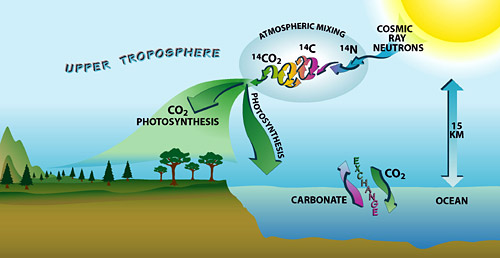Beta particles are products of radiocarbon decay. In this method, the carbon sample is first converted to carbon dioxide gas before measurement in gas proportional counters takes place. Liquid scintillation counting is another radiocarbon dating technique that was popular in the s. In this method, the sample is in liquid form and a scintillator is added. This scintillator produces a flash of light when it interacts with a beta particle.

A vial with a sample is passed between two photomultipliers, and only when both devices register the flash of light that a count is made. Accelerator mass spectrometry AMS is a modern radiocarbon dating method that is considered to be the more efficient way to measure radiocarbon content of a sample. In this method, the carbon 14 content is directly measured relative to the carbon 12 and carbon 13 present.
The method does not count beta particles but the number of carbon atoms present in the sample and the proportion of the isotopes. Not all materials can be radiocarbon dated. Most, if not all, organic compounds can be dated.
Rescue Archaeology
Samples that have been radiocarbon dated since the inception of the method include charcoal , wood , twigs, seeds , bones , shells , leather, peat , lake mud, soil , hair, pottery , pollen , wall paintings, corals, blood residues, fabrics , paper or parchment, resins, and water , among others. Physical and chemical pretreatments are done on these materials to remove possible contaminants before they are analyzed for their radiocarbon content.
- Carbon Dating.
- hinge dating london?
- What is Radiocarbon Dating?.
The radiocarbon age of a certain sample of unknown age can be determined by measuring its carbon 14 content and comparing the result to the carbon 14 activity in modern and background samples. The principal modern standard used by radiocarbon dating labs was the Oxalic Acid I obtained from the National Institute of Standards and Technology in Maryland. This oxalic acid came from sugar beets in When the stocks of Oxalic Acid I were almost fully consumed, another standard was made from a crop of French beet molasses.
Over the years, other secondary radiocarbon standards have been made. The method uses the radioactive isotope carbon Most organic matter contains carbon. Carbon has different isotopes , which are usually not radioactive. This makes it possible to tell the age of substances that contain carbon. The method works to about 60, years old. Dates obtained are usually written as before present 'present' is Plants take up atmospheric carbon dioxide by photosynthesis , and are eaten by animals, so every living thing is constantly exchanging carbon with its environment as long as it lives.
Once it dies, however, this exchange stops. In Hessel de Vries showed that the concentration of carbon in the atmosphere varies with time and locality. Radiocarbon decays slowly in a living organism, and the amount lost is continually replenished as long as the organism takes in air or food. Once the organism dies, however, it ceases to absorb carbon, so that the amount of the radiocarbon in its tissues steadily decreases.
Because carbon decays at this constant rate, an estimate of the date at which an organism died can be made by measuring the amount of its residual radiocarbon.
Radiocarbon dating - Simple English Wikipedia, the free encyclopedia
The carbon method was developed by the American physicist Willard F. It has proved to be a versatile technique of dating fossils and archaeological specimens from to 50, years old. The method is widely used by Pleistocene geologists, anthropologists, archaeologists, and investigators in related fields. We welcome suggested improvements to any of our articles.
You can make it easier for us to review and, hopefully, publish your contribution by keeping a few points in mind. Your contribution may be further edited by our staff, and its publication is subject to our final approval. Unfortunately, our editorial approach may not be able to accommodate all contributions. Our editors will review what you've submitted, and if it meets our criteria, we'll add it to the article. Please note that our editors may make some formatting changes or correct spelling or grammatical errors, and may also contact you if any clarifications are needed.
Carbon dating
Carbon dating scientific technology. The Editors of Encyclopaedia Britannica. Learn More in these related Britannica articles:
